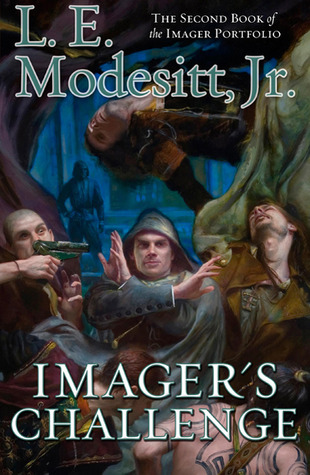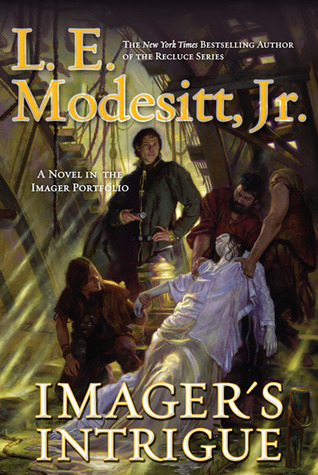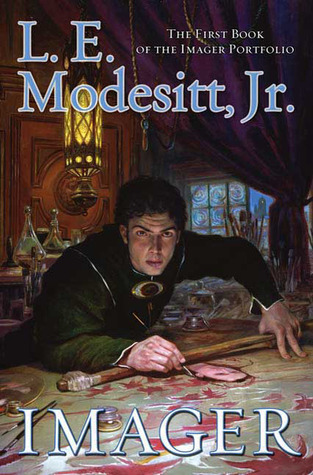Scholar, the fourth book in L.E. Modesitt, Jr.’s excellent Imager Portfolio, is due out on November 8th. In a familiar pattern for this author, the novel will start a new sub-arc in the series, set hundreds of years before the start of Imager. Because of this, it’ll probably be possible to start reading the Imager Portfolio from this point, but as I’m a fan of the author who enjoyed the first three books in the series and who generally recommends reading almost any series in its original order of publication, I’d still suggest picking up the three earlier novels first.
What follows below is a brief look back at the three “Rhenthyll” novels: Imager, Imager’s Challenge, and Imager’s Intrigue. It contains some spoilers for those three books, so you may want to skip this post if you haven’t read the Rhenthyll books yet, but this post contains nothing about Scholar.
The first time I read Imager, it struck me that it’s so immediately recognizable as an L.E. Modesitt, Jr. novel. I’m sure that some fans of the author were able to predict the early part of its plot just by looking at the included map: hmmm… looks like a city with a bunch of artist studios, and in the center there’s something called “Imager’s Isle”… so maybe we’ll have an artisan of some sort who discovers he has some strange power and ends up in a magical training organization? Bingo: Rhennthyl is a struggling journeyman portrait artist who gradually begins to realize that he has imaging talent and ultimately ends up in the Collegium Imago.
These three novels tell the story of Rhenthyll as well as the story of Solidar. There’s a balance between the two: while Rhenn is the main character and the camera is clearly centered on him, he increasingly find himself in the middle of events that affect the internal and external affairs of the country, so the author can show Rhenn’s growth while he explores the wider issues affecting this interesting fantasy world.
 A good part of the first book in the series, Imager, is taken up by describing Rhenthyll’s progress through the ranks of the Collegium. It’s clear early on that he’s a very gifted imager, so it comes as no surprise that he eventually becomes a Maitre and, as the series progresses, continues to move up in rank and strength. The struggling young portraiturist becomes a force to be reckoned with by the end of Imager‘s Intrigue, the third and (for now) final Rhenthyll novel. If you’ve read other novels by this author, there’s a good chance that the character will feel familiar, because Rhenthyll is a typical Modesitt protagonist: cerebral and driven, quiet but strong, a cautious man who nevertheless can take decisive and unconventional action when necessary.
A good part of the first book in the series, Imager, is taken up by describing Rhenthyll’s progress through the ranks of the Collegium. It’s clear early on that he’s a very gifted imager, so it comes as no surprise that he eventually becomes a Maitre and, as the series progresses, continues to move up in rank and strength. The struggling young portraiturist becomes a force to be reckoned with by the end of Imager‘s Intrigue, the third and (for now) final Rhenthyll novel. If you’ve read other novels by this author, there’s a good chance that the character will feel familiar, because Rhenthyll is a typical Modesitt protagonist: cerebral and driven, quiet but strong, a cautious man who nevertheless can take decisive and unconventional action when necessary.
While you get to know Rhenthyll, the Collegium and the “magic system” of imaging, you also learn more about the fantasy world of Terahnar. In these three novels, the story takes place in Solidar, in an era somewhere between our Renaissance and Enlightenment: society is still heavily class-based, with land-owning High Holders, a wealthy merchant class, several established artisan guilds, and the lower-class taudis. At the same time it appears that some social upheaval is on the horizon, with at least one High Holder agitating for women’s rights and a more democratic election process for the ruling Council. In terms of technology, there are railroads, fire arms and even the beginnings of an Industrial Revolution with devices such as automated weaving looms changing the economic and sociological landscape. On top of all of this, there’s the Collegium Imago: a secretive organization of “imagers” that combines aspects of a university, military organization and intelligence service. L.E. Modesitt Jr. introduces all these elements gradually throughout the story, dropping hints here and there rather than resorting to info-dumps, so that the reader slowly gathers a clear picture of this very interesting society.
 Most of the story is set in L’Excelsis, the capital city of Solidar, and we see everything through Solidaran eyes. Solidar is the largest and seemingly most powerful country, with its thriving economy, technological advantage and of course the Collegium. Early on, the focus is mostly on internal affairs, but as the plot progresses and as Rhennthyl moves up in the world, the scope of the series widens, revealing a web of international relations. Politics, economics and religion all play a role in setting Solidar apart from the other countries that directly or indirectly play a role in the story. The books include a detailed map of L’Excelsis but unfortunately no map of the wider world beyond the city, which is a shame because it initially makes it hard to picture where the other countries are in relation to each other and makes everything outside of Solidar a bit shadowy and intangible. The geopolitical lay of the land gradually becomes clear through the plot (which involves political maneuvering, terrorist attacks, assassination attempts and eventually war) and through the simple device of having Rhenn read the newspaper every morning, sort of indirectly reporting the news of the world to the reader. There are extensive meditations on the ethics of the protagonist’s actions, as well as the different types of government and religion, showing (as always with this author) various shades of gray.
Most of the story is set in L’Excelsis, the capital city of Solidar, and we see everything through Solidaran eyes. Solidar is the largest and seemingly most powerful country, with its thriving economy, technological advantage and of course the Collegium. Early on, the focus is mostly on internal affairs, but as the plot progresses and as Rhennthyl moves up in the world, the scope of the series widens, revealing a web of international relations. Politics, economics and religion all play a role in setting Solidar apart from the other countries that directly or indirectly play a role in the story. The books include a detailed map of L’Excelsis but unfortunately no map of the wider world beyond the city, which is a shame because it initially makes it hard to picture where the other countries are in relation to each other and makes everything outside of Solidar a bit shadowy and intangible. The geopolitical lay of the land gradually becomes clear through the plot (which involves political maneuvering, terrorist attacks, assassination attempts and eventually war) and through the simple device of having Rhenn read the newspaper every morning, sort of indirectly reporting the news of the world to the reader. There are extensive meditations on the ethics of the protagonist’s actions, as well as the different types of government and religion, showing (as always with this author) various shades of gray.
Rhenn works his way up through the ranks in the Collegium, from entering as a lowly prime to ending as one of the most powerful masters ever. Early on in his career, he has a run-in with the son of a High Holder which results in that son being blinded for life and Rhenn gaining a powerful enemy for life. This rivalry builds throughout the three books, allowing Modesitt, Jr. to show the incredible power and wealth of the High Holders, even compared to a relatively well-to-do family like Rhenn’s. Throughout the books we stay in touch with Rhenn’s family and its factor business, which allows more information about the world’s economy to enter into the story. On the other end of the social spectrum are the inhabitants of the taudis or slums, which become a focus in the second novel of the series, when Rhenn serves as the Imager liaison to the city patrol. Early on in Imager’s Challenge, a young taudis boy is delivered to the Collegium, and the contrast with the by then relatively powerful Rhenn really shows how much he grows and changes throughout the series. Another part of the puzzle is Seliora, Rhenn’s beautiful girlfriend and eventual wife, who is a Pharsi, an ethnic minority that seems to have the occasional ability to foretell the future. The Pharsi are also different in that they’re more matriarchal, whereas Solidar is (at least politically) still a very male-dominated society. One of the many threads in this complex story focuses on the role of women in Solidar, with Rhenn’s youngest sister, his wife Seliora and Madame D’Shendael all serving as examples of the gradually changing power balance.
There are so many threads to this story that it occasionally becomes confusing and overwhelming. Some of the elements are introduced during casual conversations over meals, or during briefings and classes, and even as part of Rhenn’s daily reading of the newspaper. The internal politics of Solidar are a complex web of intrigues and relations, and Modesitt Jr. spares no effort to demonstrate this complexity to the reader. Especially the middle section of the third novel, Imager’s Intrigue, becomes a bit muddled with highly detailed political intrigue. Because of L.E. Modesitt Jr.’s familiar first person p.o.v., reading that part of the novel can be as confusing for the reader as experiencing the events seems to be for Rhenn—but fortunately all the different strands are connected and resolved more than satisfactorily in the end.
A very recognizable L.E. Modesitt Jr. feature is the time he takes to describe the everyday details of the protagonist’s life. Whenever Rhenn has a meal, the author takes the time to describe in detail what’s on the table. There are also several loving descriptions of eating establishments. Housing, clothing, transportation—all the minute details of life in L’Excelsis are described. In the early part of Imager’s Intrigue, the author consistently shows Rhenn’s daily routine in each chapter, including the imager group workout in the morning, dropping off wife and daughter at their place of business, reading the newspaper during the rest of the coach ride to work (which also provides a handy way to keep the reader informed of the international situation), and so on. All of this is even included when nothing eventful happens, and as a matter of fact, Modesitt, Jr. will only rarely write things like “the rest of the week was routine” and instead usually describe that routine in some detail. Even though this may sound a bit dry and even boring, it’s strangely enjoyable to read because it creates an immersive reading experience and genuinely helps the reader’s understanding of the hero’s world and mindset. I’m sure it’s not something everyone will like, but personally I always enjoy L.E. Modesitt, Jr.’s oddly realistic brand of fantasy.
There are many other aspects of this series I love—so many this article would get too long if I listed them all. One of my favorite characters is Master Dichartyn, the frighteningly competent Head of Collegium Security who is such a big influence on Rhenn, but the series is full of other interesting characters who move in and out of Rhenn’s periphery. I also love the understated dialogues, often over meals, between Rhenn and the other masters, which only reveal their true depth later on. I also enjoyed the descriptions of life in L’Excelsis and on Imagisle, as usual full of details such as the housing options for the masters and even the sermons at the Anomen. Maybe most of all, I loved seeing Rhenn grow up and start a family. After all, how often do you see a fantasy hero with a wife and young child?
There are only a few aspects of this series I don’t like, and none really important enough to affect my enjoyment. I have this thing about fantasy names with the letter y in them (I feel it’s too easy to make almost any name sound exotic by throwing in some y’s or apostrophes), and these books are full of y-names. As mentioned before, the third book in the series gets a bit bogged down with politics, which really slows everything down to a snail’s pace for a while. I also feel that the third book is a bit crowded: it’s as if it contains the plots for several novels, all crammed into one cover. Then again, I enjoy this author’s stories so much that he could release them as weekly episodes for all I care.
I’m probably a rare specimen: a fan of L.E. Modesitt, Jr. who generally likes the author’s SF novels more than his fantasy. My favorite novels by him are books like The Parafaith War, Archform: Beauty, The Octagonal Raven, and more recently Haze. When asked to recommend some fantasy by Modesitt, Jr. for someone who’s new to the author, I’d be tempted to bypass the Saga of Recluce (if only because its size can be daunting for newcomers), the Corean Chronicles ,and the Spellsong Cycle. Instead, I think these three Imager novels make a great entry point for the fantasy part of this very prolific author’s oeuvre, because they’re relatively short and because they’re excellent, representative examples of his style.
Stefan Raets reads and reviews science fiction and fantasy whenever he isn’t distracted by less important things like eating and sleeping. Many of his reviews can be found at Fantasy Literature.










